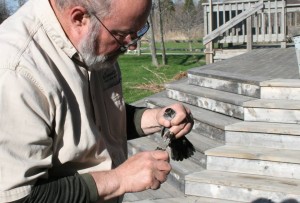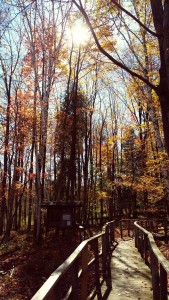Autumn Changes
Written by Corrissa Frank, Marketing and Development Coordinator
What do you think of when someone mentions autumn? What smells, sounds, tastes and visuals come to you?
Autumn is always my favorite time of year. Even though I do not look forward to the harsh temperatures of the winter, it is time for change.
We begin to react to the change of temperature such as purchasing warmer clothes or turning the heat on in our houses. Some of us may also start preparing for cultural traditions such as Thanksgiving and Christmas. Just like we react to the changes, other wildlife does the same.
 Here at Woodland Dunes, we band birds this time of year not only for research purposes, but also for school programs such as Cottonwood Trail, where students are able to learn about how Wisconsin animals survive and grow this time of year. Our Executive Director, Jim Knickelbine, is noticing a slight weight increase of the birds he has been banding. This shows that they are starting to prepare for their long journeys during migration.
Here at Woodland Dunes, we band birds this time of year not only for research purposes, but also for school programs such as Cottonwood Trail, where students are able to learn about how Wisconsin animals survive and grow this time of year. Our Executive Director, Jim Knickelbine, is noticing a slight weight increase of the birds he has been banding. This shows that they are starting to prepare for their long journeys during migration.
There are so many other changes happening in nature in reaction to the change in season. As I was sitting in my deer stand last weekend, I noticed the squirrels scurrying through the leaves on the ground and jumping from tree to tree in efforts to hide their goodies. When I was walking back home, I was able to enjoy the gorgeous colors of fall. Wooded areas surround the field where I hunt, and the vibrant yellows, reds and oranges always catch my eye.
 Taking in account all the changes coming into fall, the leaf colors are what I enjoy most (and maybe the readily available pumpkin spice lattes). The process is really remarkable.
Taking in account all the changes coming into fall, the leaf colors are what I enjoy most (and maybe the readily available pumpkin spice lattes). The process is really remarkable.
During the spring and summer, leaves produce most of the nutrients that keep the tree alive. A chemical called chlorophyll is produced in the leaf, which gives it the green color. This chemical absorbs energy from the sunlight and is used to transform carbon dioxide and water in to carbohydrates, such as sugars and starch.
When fall arrives, the length of daylight and temperature changes affect the process described above. The leaves stop their food-making process and chlorophyll breaks down. This causes the green color to disappear and the yellow and orange colors to become more visible.
Temperature, light and water supply affect how long we are able to enjoy these beautiful fall colors. Low temperatures that are still above freezing will produce the bright reds in maples, but early frost will dull those vibrant colors. If we have a lot of rain or overcast days, this may increase the vibrancy of these fall colors as well.
As one season comes to an end and another begins, it is amazing to see all the changes that take place in our own lives, as well as nature. With the hustle and bustle of the season, make sure to take some time to just enjoy the beautiful colors, crisp breeze and warm sunshine.
